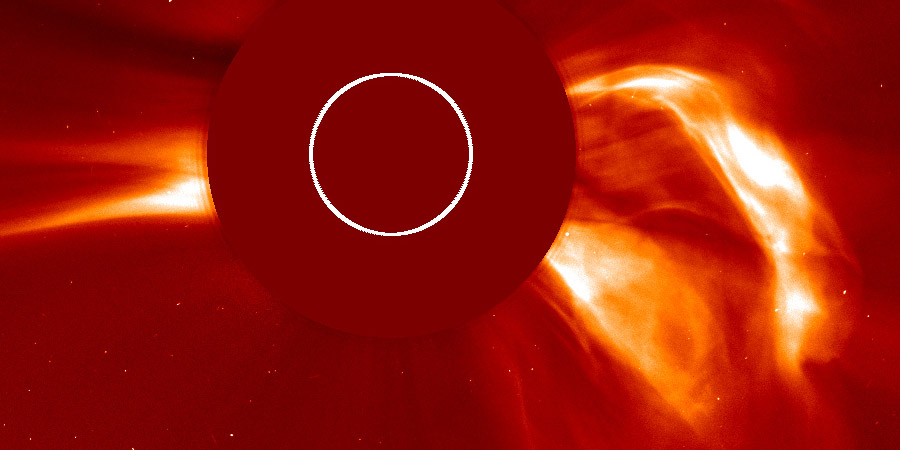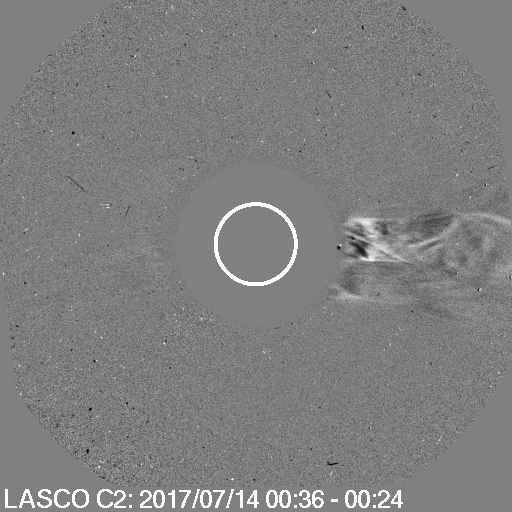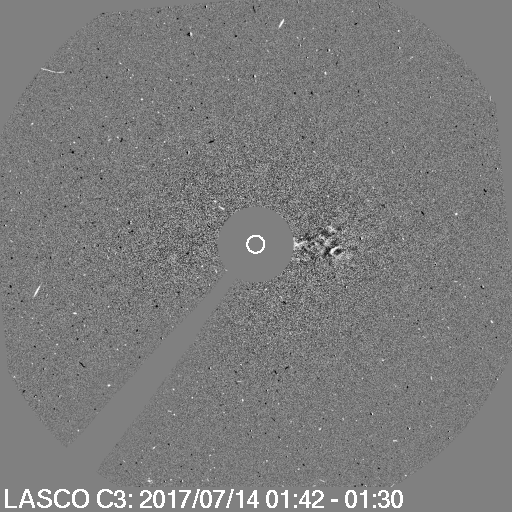Earth-directed coronal mass ejection
Friday, 14 July 2017 16:06 UTC

Sunspot region 2665 erupted this night with an M2.4 (R1-Minor) solar flare that peaked at 02:09 UTC. It was a long duration and highly eruptive event. More information about the solar flare can be found in the article that we wrote this morning.
The solar flare also caused a minor S1 solar radiation storm which could cause minor issues with HF radio communications at arctic latitudes.
But that's of course not what you came here for to read about. You want to have information about the coronal mass ejection (CME) that was launched during the M2.4 solar flare. You came to the right place!
The solar flare was associated with a very nice asymmetrical full halo coronal mass ejection. While it is not perfectly directed towards Earth (the bulk of the coronal mass ejection is heading to the south-west) we do see a very clear halo outline and that means a reasonable part of the plasma cloud is directed towards Earth, and an impact is to be expected. The animations below shows us the coronal mass ejection as seen by SOHO/LASCO.

⇧ The coronal mass ejection as captured by the SOHO/LASCO C2 coronagraph.

⇧ The coronal mass ejection as captured by the SOHO/LASCO C3 coronagraph.
Onto the number crunching:
Coronal mass ejection arrival time
It has been some time ago, but we finally get to analyze an earth-directed coronal mass ejection!
With the help of SOHO and STEREO imagery we can estimate the speed of the coronal mass ejection as it was launched from the Sun. We came to a speed of about 900km/s. This is not very fast for a coronal mass ejection but it is still faster than the most common coronal mass ejections.
A quick calculation factoring in the background solar wind speed gives us a transit time of about 2 and a half day. This gives us an estimated impact time of about 16:00 UTC on Sunday 16 July 2017. As always, the arrival time of coronal mass ejections are very hard to predict so it could arrive a couple of hours earlier or later than the indicated time. Keep this in mind. Our calculations show that the solar wind speed at Earth could increase to about 600km/s as the plasma cloud passes.
As said, the bulk of the coronal mass ejection was not directed towards our planet but we should still see a very clear impact on the ACE and DSCOVR solar wind data so be sure to follow the data closely this coming Sunday. If the impact is clear enough, our automated space weather alert system will even tweet a coronal mass ejection impact alert on our Twitter channel so be sure to follow us there as well.
Back on topic: the NOAA SWPC has already issued a moderate G2 geomagnetic storm watch for Sunday 16 July and Monday 17 July which is a very fair prediction. While we can not forecast the properties of the interplanetary magnetic field during the coronal mass ejection passage but if we are lucky and the plasma cloud carries a strong and sustained southward pointing magnetic field (Bz) we think that isolated periods where we reach strong G3 geomagnetic storming conditions are not entirely impossible. Exciting times lie ahead!
Thank you for reading this article! Did you have any trouble with the technical terms used in this article? Our help section is the place to be where you can find in-depth articles, a FAQ and a list with common abbreviations. Still puzzled? Just post on our forum where we will help you the best we can!
Latest news
Latest forum messages
Support SpaceWeatherLive.com!
A lot of people come to SpaceWeatherLive to follow the Solar activity or if there is a chance to see the aurora, but with more traffic comes higher costs to keep the servers online. If you like SpaceWeatherLive and want to support the project you can choose a subscription for an ad-free site or consider a donation. With your help we can keep SpaceWeatherLive online!
Space weather facts
| Last X-flare | 2025/12/08 | X1.1 |
| Last M-flare | 2025/12/29 | M2.2 |
| Last geomagnetic storm | 2025/12/22 | Kp5 (G1) |
| Spotless days | |
|---|---|
| Last spotless day | 2022/06/08 |
| Monthly mean Sunspot Number | |
|---|---|
| November 2025 | 91.8 -22.8 |
| December 2025 | 116.5 +24.7 |
| Last 30 days | 116.2 +30.6 |





